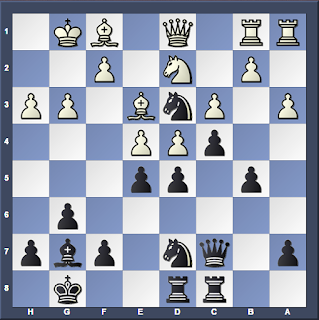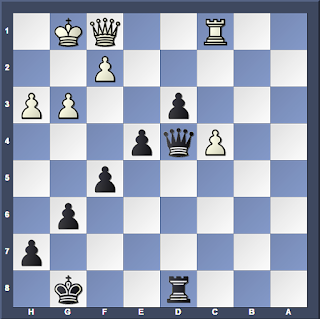Wang-Paciorkowski; 2018 Washington Chess Congress (round 4)
1.e4 g6!?
This is a highly provocative opening choice, especially against a strong player. To provide some context, at this point in the tournament I had 2.5/3 after having beaten GM David Berczes with black in round two and then drawing GM Alexander Shabalov in round three; I very much wanted to maintain my momentum and was playing for a win with black. However, instead of going into any sharp hyper-aggressive lines right out of the opening, my opponent opted for a calmer approach.
2.Nf3 Bg7 3.g3 d6 4.Bg2 Nf6 5.d3 (D)
White sets up a reversed King's Indian formation which soon turns into almost a kind of Closed Sicilian. The game continued 5. ... c5 6.0-0 Nc6 7.c3 0-0 8.Nbd2 (D)
Normally in the Closed Sicilian, white's knight is actually on c3 and later (after Nf3-e1, f2-f4 and sometimes g3-g4) re-routes either to e2-g3 or to d1-f2 combined with a pawn storm on the kingside. Instead of that, my opponent wants to play more directly in the center and makes preparations to play d3-d4. Meanwhile, my position is solid and I decide to harmoniously complete development.
8. ... Qc7 9.a3 This is a useful prophylactic move in these kinds of positions to give extra cover to the b4 square. For example, on the immediate 9.d4?! white always has to consider the consequences of 9. ... cxd4 10.cxd4 Nb4!? (10. ... Bg4! is also a strong move that should be considered), aiming at c2 and d3. On the minus side though, 9.a3 wastes a move with a pawn and opens up a hole on b3, which may or may not become important later...
9. ... Rd8 10.Re1 White still was not ready to play 10.d4?! since after 10. ... cxd4 11.cxd4 the thematic response 11. ... Bg4! puts uncomfortable pressure on the fragile center pawn duo. If one of them is forced to prematurely advance, they could become weak targets rather than strengths.
10. ... Ne5!? (D)
Offering white to exchange on e5 so I can open the d-file for my rook.
11.Qe2 As I had anticipated, White declines to make the trade. After 11.Nxe5 dxe5 white has to figure out what to do about his backward pawn on d3 which could turn into a weakness later. Now, white plans d3-d4 with tempo to finally establish a strong duo of pawns in the center. In response I quickly activate the rest of my pieces.
11. ... Bg4 I was less satisfied with the more passive 11. ... b6!? 12.d4 Nxf3+ 13.Nxf3 cxd4 14.cxd4 Bb7, when white could gain space with either 15.d5 or 15.e5!?, perhaps with some advantage.
12.h3 Bxf3?! 12. ... Bd7 13.d4 Nxf3+ 14.Nxf3 e5!? was strictly speaking a better option, not giving up the bishop pair. However, I had a specific plan in mind which will be revealed shortly. 13.Nxf3 Rac8 14.Be3 (D)
This is an important moment. I have willingly given up the bishop pair, but at least white had to waste a tempo with h2-h3 to get it, and in the meantime I have fully completed development. However, if I dawdle around, white will continue with something like Rac1 and d3-d4 occupying the center, after which my position will quickly become cramped and unpleasant. So to avoid running into a worse position like that, I have to come up with some kind of plan for counterplay either right this move, or on my very next turn. Fortunately, I did in fact have such a plan that I had been thinking about since move 11. It may not have been objectively the best way to play, but it certainly led to an interesting position after a couple more moves.
14. ... Nfd7 A preparatory move... 15.Nd2 (D)
White also makes a preparatory move. Instead, on the immediate 15.d4!? I can play 15. ... Nxf3+ 16.Bxf3 cxd4 17.cxd4 and continue with either Qc4 or Qc2, getting a little counterplay via the c-file. Now that white's knight is on d2, my Ne5 will having nothing to take on f3 and so will be forced to retreat after the imminent d3-d4. Now is the time for me to reveal my plan...
15. ... c4!? This is my ambitious idea. If white bypasses with 16.d4, then I plant a strong knight on d3 and can wreak all sorts of unpredictable havoc in white's camp from there. If white exchanges with 16.dxc4, then after 16. ... Nxc4 17.Nxc4 Qxc4 18.Qxc4 Rxc4 we get a complex ending - white has some advantage thanks to the bishop pair, but black is not without play and can create something on the queenside with a timely b5-a5-b4 minority attack. My knight on d7 is well prepared to meet the Bxa7 pawn grab with b7-b6, trapping the intruder.
My opponent chose not to enter the endgame and we continued with 16.d4 Nd3 17.Reb1 b5 (D)
The game has now become double-edged. It is difficult to say at the moment if the knight on d3 is more of a strength or a weakness. Right now its powerful influence radiates in all directions deep in enemy territory, but if white has time to undermine my supporting pawn chain with b2-b3 and a3-a4, then my intrepid explorer could get in trouble since he has no retreat squares! In any case, this is actually the most critical moment of the whole game and fortunately for me, my opponent did not make the best decision.
The game continued 18.Bf1?! (D)
My opponent's last move has the plan of Qd1, Bxd3, Qd1-f1 and finally Qf1-xd3 to win a pawn, but this is way too slow. It actually would have been quite strong to play more energetically with 18.a4! when after 18. ... a6?! 19.axb5 axb5 20.b3! white opens the queenside for his otherwise awkwardly placed rooks and starts undermining the support system for the Nd3. It seems that white would have a significant advantage in that position.
From the diagram, I wasted no time and vigorously opened the center to clear lines for my pieces: 18. ... e5! 19.Qd1 White was unwilling to play 19.d5!? himself, liberating the c5 square for either one of my knights. 19. ... d5! (D)
It felt great to be able to get this position over the board. Everything just works beautifully for black and the practical difficulties proved too much for my opponent to handle. Neither pawn capture is particularly desirable for white.
If 20.dxe5 then 20. ... dxe4 21.Nxe4 N7xe5 connects my knights and opens the d-file leaving white's queen uncomfortably staring into the gaze of my Rd8.
20.exd5 is not quite as bad, but even so I can calmly recollect the pawn with 20. ... Nb6 and if white completes his lengthy pawn grab with 21.Bxd3 cxd3 22.Qf1 Rxd5 23.Qxd3 black can continue playing actively with 23. ... f5! creating the unpleasant threat of f5-f4, trapping the bishop on e3. Considering white's dormant rooks on a1 and b1 and the immense pressure on d4, black has more than sufficient compensation for one measly pawn.
Instead, white opted to keep the tension and immediately go for 20.Bxd3 cxd3 21.Qf1? (D)
Instead it was necessary to insert 21.exd5 Nb6 and only then play 22.Qf1. Now, I have a neat tactical resource to preserve my pawn on d3.
21. ... dxe4 22.Nxe4 f5 Intending to follow up with e5-e4 after the knight moves, securing a powerful advanced protected passed pawn. White plays the most testing way with 23.Ng5 (D)
Threatening a fork on e6, but I had seen in advance that I can simply cover all my bases with 23. ... Qc4 Defending both e6 and d3. I now intend to continue with e5-e4, when the knight on g5 could even get trapped with h7-h6. If white stops me by taking on e5, then all of my pieces spring to life after ...Nxe5.
24.Nf3 e4 25.Nd2 Qc6 (D)
This is a highly unusual position. We both have protected passed d-pawns but the black one on d3 has a much stronger cramping effect than the white one on d4. If white does nothing, then I will apply further pressure with Nb6 and eventually a5-b4 to undermine the d4 pawn. I suspect my opponent grimly realized at this point how far south things had gone and rather than sit passively to watch, he frantically tried to mix things up.
26.a4 bxa4 27.d5 Pure desperation. 27. ... Qa6 There is no need to allow 27. ... Qxd5!? 28.Rxa4 when a7 falls next and white gets some counterplay (although black still has a large advantage). 28.b3 Desperately trying to activate the rooks. 28. ... Bxc3 29.Rxa4 Qb5 (D)
White has succeeding in making things messy, but in the process I have won a pawn and all my pieces are actively placed. Black should be winning now.
30.Nc4 Threatening a cheap fork on d6. 30. ... Qxd5 31.Rc1 Bd4 32.Ra5 Rc5 33.Rxa7 Ne5 (D)
Simple centralization usually gets the job done. If 34.Nxe5?, then 34. ... Rxc1 35.Qxc1 Bxa7 picks up an exchange. Otherwise, I have a triple attack on c4 which is only defended twice.
34.Ra4 Now I simplify the position by trading pieces, which generally should be the primary goal when one is ahead material: 34. ... Nxc4 35.Bxd4 Qxd4 36.Raxc4 Rxc4 37.bxc4 (D)
From here, I could win slowly by simply going after the c-pawn with 37. ... Rc8 and then queening the d-pawn by brute force, but there is a much more expedient method: simply ripping apart the white king's pawn shelter and playing for mate.
37. ... e3 38.fxe3 Otherwise e3-e2. 38. ... Qxe3+ 39.Kg2 Rb8 Activating all my forces in the attack. A rook and a queen may only be two pieces, but when working together they are more than capable of checkmating an exposed king. 40.h4 Rb2+ 41.Kh3 (D)
41. ... Qe4 The final quiet move to finish things off. White cannot defend against Qg4# without allowing Qg2#. 0-1
Next time I think I'll go through some more endgames!















I’ve always wondered what a great player thinks about. Thanks.
ReplyDeleteThis is TJ, thanks for the game Lev! You absolutely destroyed him! It's kind of ironic the octopus super knight was replaced by an even stronger protected passed pawn 2 squares from queening, and then by the end you were so winning you didn't even need it. Poor Kevin! I always look forward to seeing your games and your analysis, and it's super helpful to have insight into how you think. Also c4 is a very interesting plan which I was ecstatic to have spotted right before you revealed it (why else would you play Bxf3 and Nfd7). Your games have helped me improve a lot thank you so much for your posts. I'm looking forward to some more epic endgames!
ReplyDelete